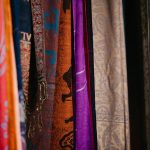I've learned that the first uses of leather were pretty cool and super important for early humans. They made clothes and shoes from dried animal hides, which kept them warm and protected from harsh weather. They also used leather in building shelters, making it a key material for survival. Plus, they crafted things like shields and armor for protection while hunting or in battle. Leather was literally everywhere, from the stuff they wore to the homes they lived in. There's a lot more about how leather shaped ancient lives if you keep looking into this topic.
Table of Contents
Key Takeaways
- Leather was first used for clothing, providing protection and warmth.
- It played a crucial role in shelter construction since 50,000 BC.
- Early civilizations crafted leather footwear for protection against elements.
- Leather was essential in making shields, armor, and weapon sheaths.
- It was used to create harnesses, saddles, and reins for transportation.
Early Leather Clothing
Leather clothing first came into play when ancient folks used dried animal hides for protection and warmth. It's fascinating to think about how this material, used so commonly today, got its start. Let's dive deep into the origins and early uses of leather clothing, particularly focusing on primitive societies and early civilizations.
Primitive societies were quite resourceful and understood the value of what nature provided, including animal skins. By around 1300 BC, these societies weren't just using hides; they were turning them into crafted leather artifacts. This wasn't just about fashion—leather was essential for survival. It provided a durable material that could withstand the elements, essential for a nomadic lifestyle.
As techniques evolved, early civilizations developed methods to soften and preserve these hides, enhancing their utility and wearability. This progress was crucial as it allowed leather to become more than just a rough, protective layer.
Jumping over to the ancient Greeks, they really took leather usage to new artistic heights. During the Homeric era, Greeks crafted intricate sandals from leather. This shows the shift from purely utilitarian to also include aesthetic considerations in leather crafting. Their approach influenced countless generations on the versatility and value of leather in cultural expressions.
Shelter and Housing Applications
Often, our prehistoric ancestors turned to animal hides as their go-to material for constructing shelters and other forms of housing. These hides, primarily sourced from wild animals, provided essential protection against harsh weather conditions. In prehistoric times, the use of leather wasn't just practical; it was a survival tactic that utilized every part of an animal.
Leather was used extensively in various shelter and housing applications. Imagine back then, the crafting of tents. These weren't the modern, synthetic materials we've today but rather, tough, dried skins that had been carefully treated to last through the seasons. Around 1300 BC, our ancestors even developed specific techniques to soften and preserve these hides, enhancing their durability and comfort as protective coverings.
The use of leather in these applications dates back to roughly 50,000 BC. This longevity in the timeline of human civilization underscores how crucial leather was. It wasn't merely for wearables like clothing and footwear but was integral in creating secure living spaces. This adaptability and resourcefulness in using leather for shelters highlight the ingenuity of early humans, making the most out of the resources at their disposal.
Leather in Weaponry
While we've seen how leather helped early humans build shelters, it also played a big role in their defense strategies, especially in creating weaponry. In the realm of ancient warfare, leather wasn't just another material; it was a game-changer. The Greeks and Romans, for instance, crafted leather into shields and protective armor. This wasn't just about style—leather provided crucial durability and protection in the thick of battle.
The use of leather in ancient weaponry extended beyond just shields and armor. Leather sheaths, essential for keeping swords and daggers secure and sharp, were common. Imagine a soldier or a warrior without a sheath—his weapon could be a liability rather than an asset. But with leather, these weapons were safely stowed and ready for quick draws in battle situations.
Moreover, leather's flexibility and toughness made it ideal for military equipment that needed to withstand the rigors of war yet remain lightweight enough for soldiers to move freely. This balance of protection and mobility was vital in ancient military strategies, highlighting leather's indispensable role in early defensive and offensive preparations. Thus, in ancient times, leather truly shaped the way battles were fought and won.
Ancient Footwear Uses
Shifting our focus to ancient footwear, it's clear that leather shoes weren't just about style but also offered significant protection. When I delve into the historical use of leather in footwear by ancient civilizations, it's fascinating to see how they utilized this durable material. The oldest known leather shoes, discovered in Armenia and dating back to 3,500 BC, reveal that even our earliest ancestors understood the importance of protecting their feet.
Ancient Egyptians weren't far behind, crafting footwear primarily from leather. This not only highlights leather's widespread availability but also its adaptability and resilience, essential for daily activities across different terrains. Similarly, during the Homeric era, the Greeks advanced the design of leather sandals, which became synonymous with their culture.
These instances show that leather shoes have been a cornerstone of human development. Their evolution wasn't just about fashion; it was about creating a robust barrier against the natural elements. This tradition of leather footwear across various ancient societies underscores its enduring appeal and functionality, making it a staple in human attire through the ages. The historical significance of leather shoes in ancient times is both impressive and illuminating.
Leather for Transportation
In exploring leather's role in transportation, it's clear that this durable material was essential for early travel systems. The tanning processes developed over centuries turned raw hides into high-quality leather goods that were both functional and stylish. This craftsmanship was indispensable in crafting items that withstood the rigors of early transportation methods.
Here's how leather made a difference in the world of transportation:
- Harnesses, Saddles, and Reins: Leather was pivotal in creating durable harnesses and saddles, enabling horse-drawn travel. Its strength and flexibility provided the necessary support and control for riders and carriage drivers.
- Upholstery in Carriages and Wagons: To enhance comfort and add a touch of elegance, carriages and wagons often featured leather upholstery. This not only improved the aesthetics but also increased the durability of these vehicles.
- Straps and Belts: Essential for the functioning of horse-drawn vehicles, leather straps and belts held components together and ensured smooth operation.
- Early Automobiles: When cars first rolled out, leather seats and covers were standard. They offered comfort, style, and a luxury feel that early motorists appreciated.
From horse-drawn carriages to the first cars, leather's role in transportation has been both transformative and enduring. It's fascinating to see how integral leather was in moving societies forward.
Leather in Containers and Storage
I'm excited to talk about how ancient civilizations used leather for containers and storage. They crafted items like water carriers and food pouches, which were crucial for their daily lives and survival.
These leather goods not only served practical purposes but also showed off the incredible skill and creativity of early leatherworkers.
Ancient Water Carriers
Leather's durability and flexibility made it an ideal choice for ancient civilizations to create water containers and storage vessels. Our ancestors used leather extensively, recognizing its unique properties that were perfect for their needs. Here's why they relied so heavily on leather for their water containers:
- Durability: Leather could withstand the wear and tear of daily use, essential for nomadic lifestyles.
- Flexibility: Malleable nature allowed for easy packing and transportation.
- Water Resistance: Properly treated leather held water without leaking.
- Availability: Leather was readily available and could be crafted into various shapes and sizes.
This adept use of leather showcases just how ingenious our ancestors were in utilizing resources around them.
Early Protective Wrappings
Ancient civilizations often turned to leather as a go-to material for creating protective wrappings for storage and transportation. They really got how useful leather could be, not just for looking good, but for practical stuff too. Leather containers were a big deal for keeping things like food, liquids, and other goods safe from the elements. And it wasn't just about utility—these items often featured beautiful designs that showed off the craftsmanship of the time.
Leather pouches were another smart invention. People used them to carry everyday essentials like tools and medicines. This wasn't just about making life easier; it was about survival. Using leather this way highlights how inventive and resourceful these early folks were.
Historic Food Pouches
Historic food pouches made of leather were a game-changer for early humans, letting them store and carry food safely during their travels. As someone fascinated by how our ancestors adapted, I find the use of leather in making these pouches particularly clever. Here's why these pouches were so crucial:
- Durability: Leather is tough, so these pouches could withstand rough nomadic lifestyles.
- Protection: They shielded the food from moisture and pests, keeping it edible longer.
- Portability: Easy to carry, these pouches suited the mobile lives of early humans.
- Versatility: Leather's adaptability allowed for various pouch sizes and shapes, catering to different needs.
Really, leather food pouches underline the ingenuity of early societies in using available resources to enhance their daily lives.
Rituals and Cultural Significance
Now let's talk about how leather was more than just a material; it held deep meanings in rituals and cultures.
From sacred ceremonial attire that marked important events to symbolic tribal roles that defined social hierarchies, leather was pivotal.
It also represented spiritual beliefs, embodying the values and traditions of various communities.
Sacred Ceremonial Attire
Leather was crucial in sacred ceremonies across various cultures, symbolizing spirituality and reverence. When we dive into sacred ceremonial attire, the importance of leather in rituals and ceremonies is undeniable. The historical and cultural significance of these leather items is immense, often becoming heirlooms. Here's why leather was so valued:
- Spiritual Symbolism: Leather represented purity and was integral to connecting with the divine.
- Intricate Craftsmanship: The detailed designs on leather signified the ceremony's importance.
- Durability: High-quality leather ensured that attire lasted through generations.
- Cultural Heritage: Each piece carried unique cultural stories and traditions.
Understanding these aspects helps us appreciate not just the material but the deep-rooted cultural connections it fostered.
Symbolic Tribal Roles
In many tribal communities, leather is more than just material; it's a crucial element in ceremonies that define roles and express deep cultural significance. Tribes crafted ceremonial garments, headdresses, and accessories from leather, each piece rich with symbolic meaning. These items weren't just for show; they marked the wearer's status and power within the tribe.
I've learned that the crafting of these items was a skill passed down through generations, making each piece a link to the tribe's heritage. This use of leather in tribal rituals really shows how essential it wasn't just in daily life but as a key part of maintaining and celebrating cultural identity. It's fascinating how leather was so central in expressing who they were and what they valued.
Spiritual Beliefs Representation
Many cultures have used leather in their spiritual rituals, believing it to hold protective and ceremonial qualities. Here's a quick look at how leather played a vital role in these contexts:
- Ceremonial Clothing: High priests and shamans often wore leather garments during religious ceremonies, symbolizing authority and divine connection.
- Protective Amulets: Small leather amulets were crafted to ward off evil spirits and bring protection to the wearer during sacred rituals.
- Symbolic Artifacts: Leather items, such as masks and belts, were used to represent spiritual entities or ancestral spirits in various cultural rites.
- Ritual Offerings: Communities frequently offered leather goods to deities or spirits as a sign of reverence and to seek blessings.
It's fascinating how deeply intertwined leather was with spiritual beliefs!
Frequently Asked Questions
What Are the Uses of Leather?
I use leather for many things: jackets, boots, belts, and bags. It's durable, stylish, and ages well. Plus, it's versatile for furniture and car upholstery, showing its wide range of applications.
Why Did Early Man Use Leather Clothing?
I'd say early man wore leather clothing because it provided protection from harsh weather, helped in survival, and was durable. It was essential for staying warm and safe during hunting and gathering.
What Is the Most Common Use for Leather?
I've learned that the most common use for leather today is in making shoes, which takes up about half of all leather produced. It's super popular for its durability and flexible qualities.
What Is the Cultural Significance of Leather?
Leather's cultural significance is profound; it's symbolized power and distinction throughout history. It's been essential in fashion, protection, and status, reflecting its durability and versatility in countless societies.
- How Does Ring Spun Cotton Affect Garment Fit and Shape Retention? - August 13, 2024
- What Are the Challenges in Producing Ring Spun Cotton? - August 13, 2024
- Is Ring Spun Cotton Suitable for Plus-Size Clothing? - August 13, 2024






